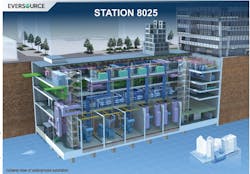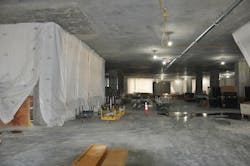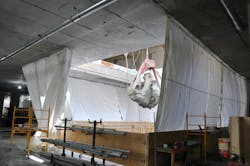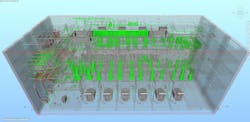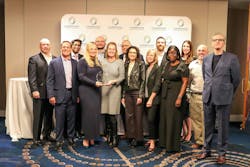Eversource Energy’s Cambridge Underground Substation
Key Highlights
- The project features the first fully underground substation in the U.S., designed to meet increasing electrical loads in a space-constrained urban environment.
- Advanced 3D and 4D modeling tools enabled precise coordination of complex infrastructure, ensuring safety and minimal impact on surrounding buildings and public spaces.
- Eversource adopted eco-friendly EconiQ gas technology, reducing greenhouse gas emissions by approximately 65%, demonstrating a commitment to sustainability.
Editor's Note: Christopher Arnieri will be featured at the 2025 T&D World Live conference and expo this Thursday, Sept. 25, discussing underground innovations. Visit T&D World Live for more information.
Substations are a necessary part of the energy delivery value chain amidst the accelerated push for electrification in communities across North America.
Increased electrical loads require more high voltage substations, but a scarcity of available space, especially in urban areas, is forcing creative innovation and collaboration with non-utility entities like never before.
“As city planners, we have a hard time finding a place for bike racks in Kendall Square, so finding a spot for a 35,000-square-foot (outdoor substation) facility was no small task,” said Tom Evans, executive director of the Cambridge Redevelopment Authority.
Eversource Energy, a large investor-owned utility serving electricity and natural gas to 4.6 million customers in New Hampshire, Connecticut and Massachusetts, faced just such a challenge in Kendall Square in their Cambridge, Massachusetts, service territory.
Kendall Square is a neighborhood full of tech companies and home to Massachusetts’ institute of technology (MIT) and is “the most innovative square mile on the planet” according to Cambridge City Manager Yi-An Huang.
Going Underground
Eversource Energy realized that an underground substation might be their best option, but building a substation underground dramatically increases engineering complexity and its cost. While there are several indoor substations across the U.S., the only other underground substation in the U.S. was the 69 kV Park Substation in Anaheim, California, built nearly 20 years ago. That project could be considered underground because it is partially set into a hill. Notwithstanding the challenge, Eversource pivoted to a fully underground substation while maintaining their commitment to delivering safe and reliable power to their customers.
Eversource would overcome several layers of complexity to realize these benefits and would strike a delicate balance of safety, technical design, new technologies, efficiency, and environmental sensitivity.
Project Timeline
In early 2014, the utility determined a substation project would be required to serve growing electrical demand and eliminate the electrical islanding issue in most of Cambridge, where two major distribution substations were supplied by a pair of underground transmission lines with a common source and path.
In 2018 and 2019, The City of Cambridge and Eversource sought out an acceptable location for the substation. This effort identified eight potential sites to assess for the substation relocation. Boston Properties (now BxP) and the utility collaborated and agreed on the Kendall Square location, where BxP would develop the site underground. Eversource integrated its project plan with BxP’s overall site development plan, the city’s urban development plan, and the plans won majority agreement with neighborhood associations.
After executing commercial agreements with BxP, the engineering and design phase began. From 2019 through early 2025, the utility had weekly (or even more frequent) meetings with BxP and the engineering teams on this purpose-built underground structure. The project won Massachusetts Energy Facilities Siting Board (EFSB) approval on June 28, 2024, and construction started in January 2025. The substation is slated for completion in March 2029, with an initial energization date in June 2029, and full energization (all 115 kV lines cut over) in December 2031.
Intricate Engineering
From early on, project partners realized that co-locating and co-developing the underground substation along with the residential buildings and the commercial buildings would mean that using typical two-dimensional drawings would not be a viable approach. With multiple structures under development on the same site and the substation’s complex building systems, Eversource realized it would need a full 3D integrated design and building information model (BIM).
The new substation would connect to eight underground 115 kV transmission lines routing from five remote substations. This meant completely redeveloping the electrical infrastructure and addressing the existing islanding issue from a single shared substation. The transmission part of the project required six series reactors on six of the eight transmission lines to balance power flows in the Cambridge area.
To resolve the issue of rapid population growth and electricity demand, the substation will ultimately have four 90 MVA power transformers installed to ultimately serve 48 15 kV underground distribution circuits. Due to the limited space in the below grade substation, engineers deployed 2,800 linear feet of gas insulated bus (GIB) to route the transmission lines and transformer primaries throughout the entire substation.
Avoiding Greenhouse Gases
The GIS was originally to use sulfur hexafluoride (SF6) as an insulation medium. In addition to being a colorless, odorless, non-flammable gas used for insulation and arc quenching in high-voltage equipment, SF6 is also a potent greenhouse gas.
Working with Hitachi Energy, project partners decided to use the manufacturer’s EconiQ gas in all passive components in the GIS. EconiQ uses a combination of fluoronitriles (C4-FN), carbon dioxide (CO2), and oxygen to replace SF6 in gas-insulated switchgear (GIS). Using Hitachi’s insulation medium eliminated about 65% of the SF6 footprint (8,801 tonnes of CO2 equivalent avoided).
Four 90 MVA power transformers with six (ultimately eight) sections of metal-clad switchgear in a main tie main ring bus configuration will be installed to boost the 15 kV distribution system. Connections from the power transformers to the metal clad switchgear will use 15 kV bus duct. To support voltage stability, six 15 kV metal clad capacitor banks will connect to the metal-clad switchgear.
Engaging the Public
From the lessons learned during the early project outreach stage, project partners knew community outreach and stakeholder engagement was critical to the success of the Greater Cambridge Energy Program. Eversource and BxP set up a series of open houses, community group meetings and city department meetings to review and discuss all project design elements to obtain full agreement prior to the permitting process.
“There were several business considerations with the third-party developer who is building the core of the city of Cambridge and granted zoning relief needed to make this come to fruition. These business considerations included a purchase and sale agreement, numerous easements, and planning/zoning discussions with the City of Cambridge. These are not typically considered in the realm of engineering scope, but due to the large number of items that needed to be included, Engineering held a key role in these negotiations and discussions,” said Asim Fazlagic, Vice President for Substation and Transmission Line Engineering at Eversource Energy.
These meetings took stakeholder comments to the engineering teams to help design the project to meet a fully acceptable solution. Community outreach allowed Eversource and BxP to deliver a design that met the electrical needs while blending in with the existing city landscape and ultimately was able to provide public improvements that did not exist in the current area.
“As the area above the substation is going to be an open green space accessible to the public, safety was an area of high focus. Normal and emergency egress, equipment access, air intake and air exhaust all needed to be considered and made harmonious with the surrounding uses,” Fazlagic said.
3D Modeling
Performing engineering and design in 3D gave all parties access to the full site development model, allowing each to design their respective parts of the project. This direct design implementation allowed for the cross coordination of transmission lines under the floor slab of the BxP residential property and the distribution duct banks through the basement level of the commercial building. This ensured all cables entering and leaving the substation would not thermally impact electrical ratings or impact the residential and commercial building designs.
The 3D model could also coordinate the placement of all required building systems (ventilation, life safety, site communication, lighting and auxiliary power) so abutting buildings would not be interfered with. This had the bonus effect of producing a road map on how to install, operate and remove all equipment within the substation over its lifetime.
Eversource expanded the 3D BIM model to 4D (schedule integration), 5D (estimating and cost planning) and 7D (facility management and as-builts through BIM scanning). The 4D and 5D tools allow for any user to accurately see the progression of the construction and cost through the 3D model in real time. The 7D tools will bring new tools to setup Eversource’s first substation with a full digital twin. Operations and engineering will see the station’s current state and track past, current and future maintenance cycles for all equipment within the substation over the life of the assest(s).
Winning Notice
Eversource and BxP won the Cambridge Chamber of Commerce 2024 Visionary Award in November 2024 for the application of advanced design tools and processes on this project.
“This recognition emphasizes the critical role of collaboration and compromise in delivering innovative solutions that meet the unique needs of the communities we serve. We’re pleased to have had the opportunity to collaborate with BXP, the City of Cambridge, the Cambridge Redevelopment Authority, as well as the City of Somerville and Allston/Brighton on this important project. By investing in advanced technologies and infrastructure, we aim to meet the evolving energy needs of our customers in an environmentally responsible way, creating a cleaner, more resilient, and efficient grid for the future,” said Bill Quinlan, President of Transmission and Offshore Wind Projects, Eversource Energy.
On April 8, 2025, Eversource was awarded the Decarbonization Leadership Award 2025 from Hitachi Energy for the utilization of the EconiQ gas GIS equipment. Eversource was proven to be recognized by a major manufacturer and utility peers as a leader in the world’s sustainability efforts to minimize the harmful greenhouse gasses being used in the electric utility industry. “The grid of the future is sustainable, and Hitachi Energy’s EconiQ technology is the catalyst for this vision. Our partnership with Eversource in deploying the world’s first SF6-free 420 kV dead tank circuit breaker (and utilization of EconiQ on this project) is more than a technological achievement – it’s a monumental step toward a more sustainable and reliable energy system. Together, we’ve proven that the future of energy can and should be innovative, responsible, and free from SF6.”, Said Markus Heimbach Executive Vice President, Managing Director Global High Voltage Products Hitachi Energy.
Eversource Energy is building a complex transmission and distribution, fully underground substation to improve system resiliency and allow for future growth. Project partners collaborated with developers, city municipal departments, operations and maintenance crews, cable and equipment suppliers and just about every engineering discipline including electrical, civil, structural, geotechnical, life sciences, HVAC/mechanical, and plumbing and fire protection.
This required coordinating partners toward the goal of a safe, cost effective and reliable facility. Furthermore, negotiations and commercial agreements needed engineering involvement, requiring engineers to understand the big picture, the business aspects and the community relations aspects of the project.
“Wow, this day finally came,” said Eversource CEO Joe Nolan at a ceremonial groundbreaking event in January 2025. “I am on the road quite frequently with our investors, and key decisionmakers, and not a day goes by that I don’t brag about this project. No one can quite believe that we’re able to do this.”
Editor's Note: As noted above, Christopher Arnieri will be featured at the 2025 T&D World Live conference and expo this Thursday, September 25. We are offering a discount to our readers, visit T&D World LIve for more information, and enter TDWREADER to receive 20% off.
About the Author
Christopher J. Arnieri
Chris is currently the Manager of Substation Design Engineering for Eastern Massachusetts at Eversource Energy. In his current role, he oversees a team of engineers and coordinates the engineering efforts for all Substations within the eastern Massachusetts territory. Prior to this he was the Manager of Capital Project Engineering for the three state Eversource Service Territory. He has 22 years of experience in the utility industry and holds a BSEE and BSCE from Northeastern University.
John Zicko
John is currently the Director of Capital Project Engineering at Eversource Energy. In this role, he coordinates engineering efforts among disciplines and is the interface between engineering and other project team members internal and external on certain projects. Prior to this he was the Director of Substation Design Engineering for the utility’s three-state service territory and the Director of Substation Design, P&C, Substation Technical and Overhead Transmission Line Engineering for the Eastern Massachusetts service territory. He has 41 years of experience in the utility industry, holds a BSEE from Northeastern University, and MS Mgt from Lesley University and is a Licensed Professional Engineer in Massachusetts and Rhode Island.
Mike Beehler
Vice President
Mike Beehler P.E., ([email protected] ), is the national spokesperson for the Power Delivery Intelligence Initiative and the chief opportunity officer for Mike Beehler & Associates LLC. He started his career designing and building transmission lines and substations for Tucson Electric Power and the Hawaiian Electric Co. and then spent more than 20 years designing T&D infrastructure and consulting on emerging trends at Burns & McDonnell. He has written, presented and consulted on reliability-centered maintenance, critical infrastructure protection and program management. In addition, he is a well-known industry writer and speaker on the early definition of the smart grid, 3-D and building information modeling applications in T&D, and development plans for smart cities. Most recently, he is sought for his strategic leadership and vision on the application of emerging technologies in changing business models to include the integration of distributed energy resources, augmented/virtual reality and artificial intelligence. He authored the book, The Science of the Sale. Beehler is a registered professional engineer in Arizona, Florida, Hawaii, Texas, Colorado, Kansas, Georgia and Alabama. He also is a Fellow in the American Society of Civil Engineers and a member of IEEE and CIGRE.

